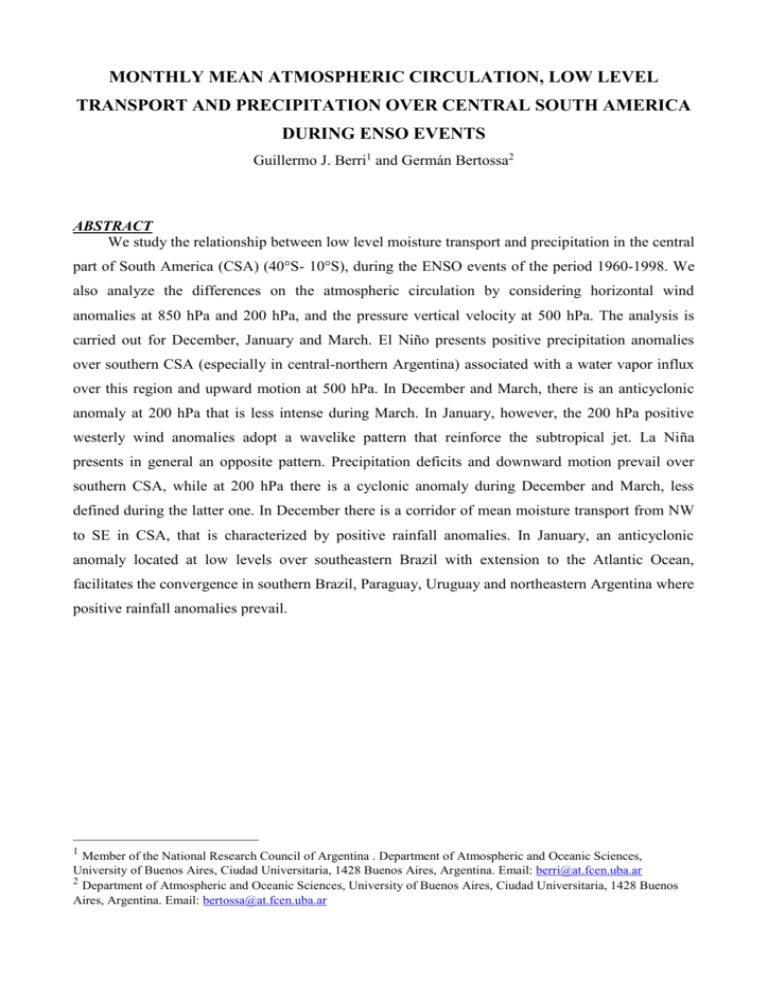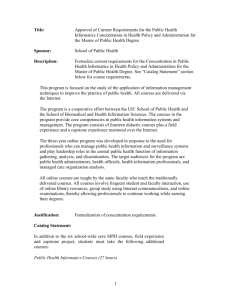references
advertisement

MONTHLY MEAN ATMOSPHERIC CIRCULATION, LOW LEVEL TRANSPORT AND PRECIPITATION OVER CENTRAL SOUTH AMERICA DURING ENSO EVENTS Guillermo J. Berri1 and Germán Bertossa2 ABSTRACT We study the relationship between low level moisture transport and precipitation in the central part of South America (CSA) (40°S- 10°S), during the ENSO events of the period 1960-1998. We also analyze the differences on the atmospheric circulation by considering horizontal wind anomalies at 850 hPa and 200 hPa, and the pressure vertical velocity at 500 hPa. The analysis is carried out for December, January and March. El Niño presents positive precipitation anomalies over southern CSA (especially in central-northern Argentina) associated with a water vapor influx over this region and upward motion at 500 hPa. In December and March, there is an anticyclonic anomaly at 200 hPa that is less intense during March. In January, however, the 200 hPa positive westerly wind anomalies adopt a wavelike pattern that reinforce the subtropical jet. La Niña presents in general an opposite pattern. Precipitation deficits and downward motion prevail over southern CSA, while at 200 hPa there is a cyclonic anomaly during December and March, less defined during the latter one. In December there is a corridor of mean moisture transport from NW to SE in CSA, that is characterized by positive rainfall anomalies. In January, an anticyclonic anomaly located at low levels over southeastern Brazil with extension to the Atlantic Ocean, facilitates the convergence in southern Brazil, Paraguay, Uruguay and northeastern Argentina where positive rainfall anomalies prevail. 1 Member of the National Research Council of Argentina . Department of Atmospheric and Oceanic Sciences, University of Buenos Aires, Ciudad Universitaria, 1428 Buenos Aires, Argentina. Email: berri@at.fcen.uba.ar 2 Department of Atmospheric and Oceanic Sciences, University of Buenos Aires, Ciudad Universitaria, 1428 Buenos Aires, Argentina. Email: bertossa@at.fcen.uba.ar DATA AND METHODOLOGY The region of study, Central South America –hereinafter CSA- is delimited between 40oS10oS. Monthly mean values of specific humidity, zonal and meridional winds components and pressure vertical velocity are obtained from the NCEP Reanalysis for the period 1960-1998. The wind components and specific humidity are taken at the following standard pressure levels: 1000 hPa, 925 hPa, 850 hPa, 700 hPa while pressure vertical velocity is only selected at 500 hPa for the same period. We also include zonal and meridional winds at 200 hPa to analyze the circulation in upper levels. Since the contribution of the upper levels is negligible, we consider the vertically integrated water vapor flux only up to 700 hPa level by the following way: Q g w 1 p 700hPa p 1000hPa qvdp (1) where v is the horizontal velocity vector, q is the specific humidity, g is the acceleration of gravity and ρw is the density of water. Anomalies in the moisture transport and precipitation are obtained as the difference between the mean value for El Niño and La Niña years, with respect to the mean value of the period 1960-1998. The monthly precipitation data are obtained from the UEA-CRU database (New, Hulme and Jones, 1999). All of these data are available on a uniform 2.5o lat x 2.5o long grid resolution. Table 1 shows the El Niño and La Niña years considered in this study. This monthly analysis is carried out in summer (December and January of the following year.) and early fall (March) El Niño years: 1963/64 – 1965/66 – 1969/70 – 1972/73 – 1976/77 – 1977/78 – 1982/83 – 1986/87 – 1991/92 – 1992/93 – 1994/95 – 1997/98 La Niña years: 1964/65 – 1970/71 – 1973/74 – 1975/76 – 1988/89 – 1995/96 – 1998/99 Table 1. El Niño and La Niña selected years RESULTS Figures 1 to 4 are described by the following way: left hand (right hand) side corresponds to El Niño (La Niña) period and from the top, each Figure is arranged in a sequence DecemberJanuary- March, respectively. Figure 1 shows the moisture transport (vector lines) and precipitation anomalies (shaded) during ENSO events in December, January and March. In December of El Niño (EN), we find an anomalous low-level cyclonic moisture circulation over CSA with a well-defined water vapor influx into northern Argentina where positive rainfall anomalies are observed. Apparently, a deepening of the continental low increases and facilitates this northerly advection of moisture (Grimm et al. 2000). During December of La Niña (LN), the opposite situation prevails over northern Argentina, with southwesterly moisture transport and precipitation deficit. From NW to SE in CSA, across Bolivia, Paraguay, southern Brazil and up to the Atlantic Ocean, there is a corridor of mean moisture transport (Figure not shown), that is characterized by positive rainfall anomalies, flanked to the north and the south by large regions with strong precipitation deficit as it is found in the right above side of Figure 1. This corridor could reinforce the South Atlantic Convergence Zone (SACZ) over the Atlantic Ocean. A strong SACZ would contribute to subsidence to both sides, which would explain the reduced precipitation appeared over central-eastern Brazil and northeastern Argentina. Nogués-Paegle and Mo (1997) found that intensification of the SACZ is associated with rainfall deficits over the subtropical plains. An anticyclonic anomalous circulation located in central-east Brazil, where precipitation deficit prevails, in connection with the southwesterly moisture transport over Argentina, help to increase water vapor convergence over southern Brazil where more positive precipitation anomalies are found. In January, during EN there is a sort of bifurcation of moisture transport in CSA coming from the NW that directs moisture flux towards central-east Brazil, causing moisture convergence in this region (Grimm 2003), and to the south over central-north of Argentina where positive rainfall anomalies are found, although less intense than in December. This bifurcation of the circulation produces precipitation deficit over southern Brazil. During LN, a clearly anticyclonic circulation is located over southeastern Brazil with extension to the Atlantic Ocean. This circulation facilitates the convergence in southern Brazil, Paraguay, Uruguay and northeastern Argentina, where positive rainfall anomalies prevail. In January we find the opposite pattern with respect to the preceding months, i.e. positive precipitation anomalies appear over that same region. Similar results were seen in other studies, for example Pisciotano et al. (1994) over Uruguay and Grimm et al. (2000) in Southern South America. Figure 1 Monthly precipitation anomalies (shaded) and 1000/700 hPa horizontal water vapor flux anomalies (vector) in December, January and March for La Niña (right) and El Niño (left) events during the period 1960-1998. March of EN presents a similar pattern of December, with precipitation deficit in northeastern CSA (over most part of central Brazil), precipitation excess over northeastern Argentina and southern Brazil and water vapor influx into northern Argentina although less intense than in December. The water vapor influx into northern Argentina is displaced eastward with respect to December in coincidence with the same positive precipitation anomalies displacement. Figure 2 shows horizontal wind anomalies in 850 hPa for December, January and March. The comparison of these figures with the moisture transport described in the Figure 1, reveals differences in vectors size (for example, in December and March of EN over central-south of CSA). As moisture transport is calculated by the equation (1), these differences suggest the presence of more water vapor available (explained by the increase of the term specific humidity), connected in general with positive precipitation anomalies (over Argentina in December and March of EN, for example). Figure 2 Monthly horizontal wind anomalies at 850 hPa in December, January and March for La Niña (right) and El Niño (left) events during the period 1960-1998. Figure 3 shows vertical motion anomalies in 500 hPa during the same period of the figures explained in Figure 1. In general, regions with positive (negative) anomalies in precipitation correspond to negative (positive) anomalies of vertical motion or upward (downward) motion. In December of LN for example, the corridor with positive precipitation anomalies is related to anomalous upward motion, flanked to the north and the south with anomalous downward motion where precipitation deficit is found. In March of LN, there is a large region with excess (deficit) precipitation over central- south of Brazil (eastern Argentina) associated with upward (downward) motion, respectively, over those regions. The opposite situation prevails in March of EN. Figure 3 Same as Figure 2 for monthly pressure vertical velocity anomalies at 500 hPa Figure 4 shows 200 hPa wind anomalies for December, January and March. In general, a clearly defined opposite pattern is found between EN and LN events. For example, in the southeastern part of CSA we observe a cyclonic anomaly in December of LN, in connection with downward motion in 500 hPa (see Figure 3) and precipitation deficit (see Figure 1). Instead in December of EN there is an opposite pattern, with an anticyclonic anomaly, associated with upward motion in 500 hPa and precipitation excess over the same region. Thus, during LN (EN), the cyclonic (anticyclonic) anomaly in the upper levels is associated with downward (upward) motion in the middle troposphere and precipitation deficit (excess). During LN (EN), besides the cyclonic (anticyclonic) anomaly over the continent in 200 hPa, there are two anticyclonic (cyclonic) anomalies over the midlatitudes of both the Atlantic and Pacific oceans. These two patterns have a barotropic structure (they are also found in 850 hPa although less intense). In January of EN, the 200 hPa positive westerly wind anomalies adopt a wavelike pattern that reinforce the subtropical jet. In LN, an easterly anomaly contributes to a weakening of the subtropical jet and there are also cyclonic and anticyclonic anomalies to the south and southeastern of CSA, respectively. The former is also found in 850 hPa (see Figure 2) but it is less intense. March presents a pattern that is similar to December. Figure 4 Same as Figure 2 at 200 hPa ACKNOWLEDGEMENTS This research was partially supported by Research Grant PICT99-6707 from Agencia Nacional de Promoción Científica y Tecnológica (ANPCyT) of Argentina, Research Grant X126 from University of Buenos Aires and Research Grant CRN-055 from the Interamerican Institute for Global Change Research (IAI). REFERENCES Grimm A., V. Barros and M. Doyle, 2000: Climate variability in Southern South America associated with El Niño and La Niña events. J. of Climate, 13, 35-58. ______, 2003: The El Niño Impact on the Summer Monsoon in Brazil: Regional Processes versus Remote Influences. Journal of Climate, 16, 263–280. New, M., M. Hulme, and P. Jones, 1999: Representing twentieth-century space-time climate variability. Part I: Development of a 1961-90 mean monthly terrestrial climatology. J. Climate, 12, 829-856. Nogués-Paegle J, Mo K.C. 1997: Alternating wet and dry conditions over South America during summer. Mon. Wea. Rev., 125, 279-291. Pisciottano G, Diaz A, Cazes G, Mechoso C. 1994: El-Niño Southern Oscillation impact on rainfall in Uruguay. J. Climate, 7, 1286-1302.





